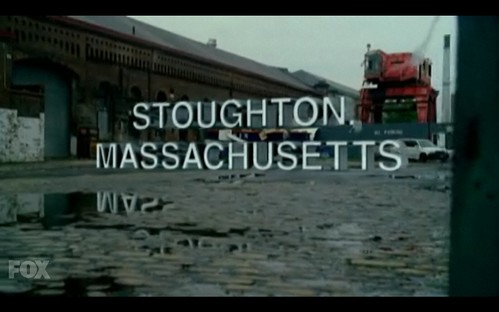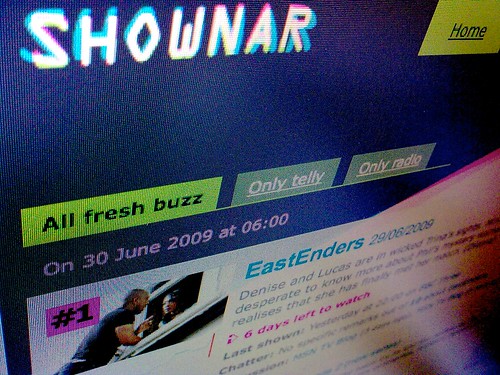-
"Whenever is a Ruby gem that provides a clear syntax for defining cron jobs. It outputs valid cron syntax and can even write your crontab file for you. It is designed to work well with Rails applications and can be deployed with Capistrano. Whenever works fine independently as well." Pretty DSL for generating crontab in a rubyish manner.
-
"William Petersen as Gil Grissom, David Caruso as Horatio Caine, Gary Sinese as Mac Taylor, Mark Harmon as Jethro Gibbs, Anthony LaPaglia as Jack Malone. These guys are the franchise players of primetime TV. But they are also role models. Each represents a different management style." I'd work for Grissom instead of Gibbs in a flash, personally, but I'm an eccentric and I like eccentric managers.
-
I am not an expert in these matters, but that is rather lovely.
-
That performance of Billie Jean. But with a Giant White Glove. Brilliant.
-
"On May 4th, 2007, we asked internet users to help isolate Michael Jackson's white glove in all 10,060 frames of his nationally televised landmark performance of Billy Jean. 72 hours later 125,000 gloves had been located. wgt_data_v1.txt (listed below) is the culmination of data collected. It is released here for all to download and use as an input into any digital system. Just as the data was gathered collectively it is our hope that it will be visualized collectively." This is amazing. And what it leads to is even better.
-
Thoughtbot discover their RFID door-lock system has an API. A short bash at some code later, and they now have theme songs when they enter the office.
-
"From 30th June to 25th August, I'll be following a route across Scotland from the south western tip of Mull to the outskirts of Edinburgh, as charted in Chapters 14–27 of Robert Louis Stevenson’s ‘Kidnapped’." I remember talking to Tim about this at BookCamp; it's great to see it in-the-world.
-
"Peter Newman's Skystation is a circular sculpture inspired by the form of Le Corbusier's LC4 chaise longue which encourages the user to lie down and contemplate the vast expanse of space above and beyond." I rather like that. Doesn't look comfortable, but I agree with the sentiment.
-
"After years of observation and reverse engineering I am proud to say I have been able to reproduce the IE6 algorithm to break even the most standards-compliant websites." Hur hur hur.
Text In The World
07 July 2009
After a long period underground, Ubisoft’s Splinter Cell: Conviction emerged at E3 substantially different to its previous incarnations. And whilst I, for one, am grateful for the removal of Sam Fisher’s trampy hairdo, the new feature that got me really, really excited seems to have passed with relatively little fanfare. Here it is:

Mission objectives – or, at least, reminders thereof – written into the environment, mapped over space, appearing to the player along; subjective and stylistic, but never part of a HUD. It’s classy and striking, and not something people are playing with in games nearly enough. Prior to this, easily my favourite type design in games came from Codemasters’ GRID:

which placed text into the world as first-class 3D objects, and let the player spin and pivot the camera around it, as if to emphasise both its subjectivity and genuine 3D-ness.
But this has been a thing in movies and TV for a while, now. Here’s JJ Abrams’ Fringe:

which even nails the reflections in the water. And, of course, one of the earliest points of reference for this in genuine 3D is David Fincher’s Panic Room:

which, as Ben has pointed out, owes a great debt to Saul Bass’ titles for North by Northwest:

which makes quite a nice list.
-
"Bayer’s DIDGET™ is the only blood glucose meter that plugs into a Nintendo DS™ or Nintendo DS™ Lite system. This unique meter helps encourage consistent testing with reward points that children can use to buy items within the game and unlock new game levels." Blood glucose monitor for diabetics that plugs into your Nintendo DS. Utterly awesome, and exactly what a new world of products should look like.
-
"I have realized that the traditional omelet form (eggs and cheese) is bourgeois. Today I tried making one out of cigarette, some coffee, and four tiny stones. I fed it to Malraux, who puked. I am encouraged, but my journey is still long." How have I only just encountered this?
-
Some jolly good stuff from Chris, notably "And I Saw..". I mainly like it, though, because he went and made a thing, and it definitely worked, and it's so, so simple.
Conference time: Develop 2009
06 July 2009
Next week is Develop in Brighton, the UK’s premiere games industry conference, and I’m going to be involved in two sessions there.
The first session is part of “Evolve“, a single day before the conference proper combining their old online and mobile tracks into something more focused on the edges of the games industry – so now including social and casual gaming as well.
With a panel of industry experts, I’ll be asking the question “What Do Social Networking Sites Have To Offer The Games Industry“:
Facebook and Myspace each have over 100m unique users. The users of these sites are not only coordinating their leisure time through them, but spending their leisure time on them, and even playing games on them. What does that mean for the games industry? How can traditional games and game companies engage with the social networks – their users, their platforms, and the core gamers already using them? Are Facebookers casual-gamers-in-waiting? This panel invites representatives from top social networks to explain what gaming means for their products, and how they can support your efforts as games developers.
Hopefully, given the panel’s strengths and expertise, we can come up with some wide-ranging – and interesting – answers.
In addition to that, as part of the conference proper, I’m going to be talking about Games As A Service: what service design is, what it means for games and products of the future, and how some of the territory Schulze & Webb has been exploring when it comes to unproduct might apply to games. It’s called Never Mind The Box: Games As A Service:
The effort and finances needed to build full retail games is growing unsustainable. But what if you weren’t making a product? What would Games As A Service look like? Services encourage loyalty; they turn products into platforms; they empower users; they play well with others and connect to existing services; and at the large scale, they wrap other products and become super-products. Using examples from inside and outside the games industry – from tiny, open-source Davids to console-licensed Goliaths – Tom Armitage examines already successful notions of service design and explores what it will mean for your games, big or small.
So that’s next week, then. Better start writing them. And if you’re going to be at Develop next week – do come say hello!
-
"Ultimately, when I reject narrative techniques in favor of ludic ones, what I am really saying is that I reject traditional authorship. I reject the notion that what I think you will find emotionally engaging and compelling – and then build and deliver to you to consume – is innately superior to what you think is emotionally compelling. By extension, I reject the idea that I can make you feel the loss of a friend in a more compelling way by authoring an irreversible system than you could make yourself feel by playing with a system wherein a friend can be both dead and alive simultaneously and wherein his very existence can be in flux based on your playful whim… This discussion is not about how to make a game more meaningful. It is about how games mean." Yep, I still want to marry Clint Hocking.
-
"The next time you see an application you like, think very long and hard about all the user-oriented details that went into making it a pleasure to use, before decrying how you could trivially reimplement the entire damn thing in a weekend. Nine times out of ten, when you think an application was ridiculously easy to implement, you’re completely missing the user side of the story." Yes. Similarly: what you don't see is the decision-making, everything that was thrown away.
Shownar: or, so, we made a thing
03 July 2009
It’s been around the internet a bit already, but I can now show you what I’ve been working on for much of the time since I joined Schulze & Webb.
Enter Shownar:

What’s Shownar? Matt explained it over at Pulse Laser, the Schulze & Webb blog:
Shownar tracks millions of blogs and Twitter plus other microblogging services, and finds people talking about BBC telly and radio. Then it datamines to see where the conversations are and what shows are surprisingly popular.
And over at the BBC Internet Blog, Dan Taylor quotes the about page:
First, it will help you find shows that others have not only watched, but are talking about. Hopefully it’ll throw up a few hidden gems. People’s interest, attention and engagement with shows are more important to Shownar than viewing figures; the audience size of a documentary on BBC FOUR, for instance, will never approach that of EastEnders, but if that documentary sparks a lot of interest and comment – even discussion – we want to highlight it. And second, when you’ve found a show of interest, we want to assist your onward journey by generating links to related discussions elsewhere on the web. In the same way news stories are improved by linking out to the same story on other news sites, we believe shows are improved by connecting them to the wider discussion and their audience.
Of course, I didn’t work on this alone; as Matt points out, there was a good-sized team from both the BBC and Schulze & Webb, and it was great to work with so many talented and sharp people, all of whom have left their mark on the project.
People have been pretty enthusiastic so far, which is always nice to see. It’s also great been watching stories emerge – stories of what we found to watch or listen to in the office, ways our viewing and listening habits have changed, and there’s not much better praise than constantly wanting to use a thing you’ve made.
So there we go, Shownar. Another thing in the world.
-
Monster Hunter's success comes down to its local-only multiplayer, which has been a huge hit in Japan, but less so over here. To promote Freedom Unite, Capcom open a pop-up meeting-space on Charing Cross Road, simply to provide a space for Monster Hunters to congregate. You'll need a PSP to be allowed to enter. I have no idea if this is going to work out, but there's something about the idea – creating public spaces designed for the playing of videogames, together – that I rather like.
-
"this is good level design." A lovely dissection of a couple of screens from Super Mario Land; detailed, spot-on, carefuly analysis from Anna Anthropy. Amazing what you can do with four types of block.
-
"Why are so many people getting divorced today? It’s because most of us don’t have extended families anymore. It used to be that when a man and a woman got married, the bride got a lot more people to talk to about everything. The groom got a lot more pals to tell dumb jokes to." The rest of the quotation is where the magic happens.
-
In which photographers, or, more likely, their assistants, upload lighting test shots. Some are striking; some are practical; some are made of awesome. Fun!
-
The last keffiyeh factory in Palestine is going out of business; they're all made in China now. Well done, hipsters!
-
Recommended by Matt Haughey.